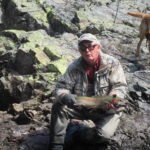Rumors that the Minnesota DNR is secretly stocking wild turkeys along Lake Superior’s North Shore are not true. I verified that with DNR assistant wildlife manager Dave Ingebrigtsen in Grand Marais last week. Yet Ingebrigtsen, nor anyone else, can explain the rash of wild turkey sightings that have occurred this spring from Two Harbors to beyond Grand Marais. It’s been the talk of local coffee shops, the Grand Marais radio station and social media.
Last week, wildlife photographer Nace Hagemann posted a photo he took of a hen turkey along the Gunflint Trail. The posting touched off a conversation among dozens of Facebook users, some of whom reported seeing turkeys near the North Shore communities of Lutsen, Tofte and Schroeder in Cook County, as well as several locations in Lake County and in St. Louis County north of Duluth. Many of the sightings occurred in recent weeks.
“It’s the only one I’ve seen up here,” Hagemann told me in a telephone interview. “I jumped out of my truck with the camera and it just walked ahead of me in the ditch. It was within 15 feet of me.”
Hagemann saw the bird in the mid-Trail area near the former Windigo Lodge, which recently changed hands and was renamed the Poplar Haus. He said the bird seemed unafraid of him, leading him to question if it was a truly wild bird. However, Hagemann lives in the mid-Trail area, which is very small community. He was unaware of any neighbors that are raising poultry.
“About the only pets up here are dogs and cats,” he said.
But Hagemann was scratching his head about how a wild turkey could survive along the Gunflint Trail, which has the longest, snowiest winters in northern Minnesota. When we spoke on May 11, there were still remnant patches of snow on the ground. While people on his Facebook page assured him that turkeys could survive in the “north,” saying they were seeing them in their Iowa backyards, he pointed out just how far north the Gunflint Trail really is.
“In some years, they’re still ice fishing up here on the May fishing opener,” he said. “I joke that just as soon as the snow melts, we have to be ready to pull out the shovels again.”
Wild turkeys can handle cold, provided they have something to eat. That’s a seriously limiting factor in the boreal forests along the Gunflint Trail. There is no agriculture, no livestock operations and no mast trees such as oaks. Most winters, the ground is blanketed with two to four feet of snow for months, making it impossible for ground-feeding birds, such as turkeys, to find food. About the only food sources available would be bird feeders or folks who are feeding deer. And guess what? Deer are few and far between, as are year-round human residents.
Of course, this likely means turkeys don’t have much of a chance of surviving in the boreal forests, but that doesn’t explain why there have been so many sightings this spring. Where are these birds coming from? Researching northeastern Minnesota turkey sightings last year, wildlife managers told me they believe the birds are free-ranging from backyard poultry operations. Actual wild turkeys seem to be expanding where there is a mix of field and forest, such as west of Duluth and, according to a recent DNR press release, are now being seen as far north as the Iron Range.
In the press release, the DNR’s spin doctors pointed out that all of Minnesota is now open to turkey hunting, so northeastern Minnesota hunters could, so to speak, take advantage of the new game in town. That’s true. But the DNR has left a big question unanswered: How will wild turkeys, an invasive species, affect northeastern Minnesota’s native flora and fauna?
A few months ago, a woman stopped by my office who was a North Shore native now living south of Duluth. She had read a story I’d written about a new effort to restore red pine, white pine and white cedar to the North Shore forests. Based on climate change models, the foresters are also introducing oak plantings, figuring as the climate warms, oak will begin growing on the North Shore. A few stands of natural oak now exist in places such as Tettegouche State Park, but it is by no means a common species. She thought introducing oak where it doesn’t presently exist was irresponsible. Why?
“Oaks will attract turkeys,” she said. “And they don’t belong on the North Shore.”
Like many folks in the portions of northern Minnesota that have already been invaded by wild turkeys, she believed that they have a negative effect on ruffed grouse populations. No one really knows whether or not this is true, because there is very little research on the topic. Even less research exists on what effects turkeys may have on other aspects of the boreal forest. Considering the state’s intensive research into other invasive species, albeit not ones for which it can hold open seasons, this seems contrary to business as usual.
The DNR spins the northward advance of wild turkeys as a natural occurrence, possibly aided by climate change, but this belies a couple of facts. The first is that in the past, the DNR stocked turkeys north of their then-existing range in the state with the intention of introducing them to all available habitat. The second is that harsh winters remain a fact of life in northeastern Minnesota, especially in the boreal forests of St. Louis, Lake and Cook counties.
Frankly, turkeys seem to be advancing northward far more quickly than the science needed to truly understand what that may mean for native species. Wildlife management is supposed to be science based. When it comes to wild turkeys, it appears wildlife researchers have some catching up to do.



